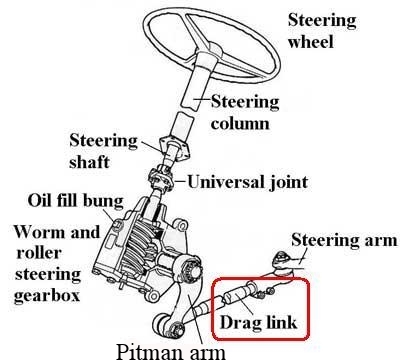Drag link on:
[Wikipedia]
[Google]
[Amazon]
 A drag link converts rotary motion from a crank arm, to a second bellcrank, usually in an automotive steering system.
While the origin of the term is not clear, it pre-dates the automobile, and is described as in use in 1849 as a means of rotating a Ducie cultivator being operated by cable by stationary steam engine (or between engines).
A drag link converts rotary motion from a crank arm, to a second bellcrank, usually in an automotive steering system.
While the origin of the term is not clear, it pre-dates the automobile, and is described as in use in 1849 as a means of rotating a Ducie cultivator being operated by cable by stationary steam engine (or between engines).
Drag link
/ref>
Automotive use
The term is commonly used inautomotive technology
Automotive engineering, along with aerospace engineering and naval architecture, is a branch of vehicle engineering, incorporating elements of mechanical, electrical, electronic, software, and safety engineering as applied to the design, manufac ...
for the link in steering linkage that connects the drop arm (also called pitman arm
A Pitman arm is a shaft that translates rotary or angular movement into linear movement, or vice versa. Pitman arms are commonly found in water pumping windmills, automotive steering systems, and sewing machines.
In windmills, the Pitman arm con ...
) on the steering box to a ''steering arm'' which causes the wheels to steer the vehicle. Normally the drop link connects to one wheel which is connected to the other wheel by a track rod (or tie rod
A tie rod or tie bar (also known as a hanger rod if vertical) is a slender structural unit used as a tie and (in most applications) capable of carrying tensile loads only.
It is any rod or bar-shaped structural member designed to prevent the separa ...
) which is an adjustable rod which determines the relative wheel alignment.
Typically, one end of the drag link is connected via the drop arm (also called Pitman arm
A Pitman arm is a shaft that translates rotary or angular movement into linear movement, or vice versa. Pitman arms are commonly found in water pumping windmills, automotive steering systems, and sewing machines.
In windmills, the Pitman arm con ...
) and steering gearbox to the steering wheel (providing the connection between the driver and the steering system); the other end is attached to one of the wheels by the steering arm.
An alternate steering mechanism is a rack and pinion
A rack and pinion is a type of linear actuator that comprises a circular gear (the '' pinion'') engaging a linear gear (the ''rack''). Together, they convert rotational motion into linear motion. Rotating the pinion causes the rack to be driven ...
, a three bar linkage that eliminates the drag link by directly moving a center link.
"The drag link connects the pitman arm to the steering arm, or in some applications it connects to the tie rod assembly. Unlike a center link, the drag link does not connect to an idler arm, and has no inner tie rod ends attached to it. On some applications the drag link swings from the front to the rear of the vehicle. On these applications the drag link connects to the steering arm located at the wheel. In some Jeep applications, the drag link will swing from right to left on the vehicle and will connect to the steering arm at the wheel. Drag links can be a solid one-piece design or an adjustable design. Many drag links have replaceable or rebuildable ends."/ref>
Effect of wear
Wear in the joints at the end of the drag link in a steering system will result in play in the steering. It will not affect the wheel alignment as that is determined by the track rod (tie rod in USA).References